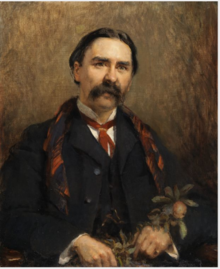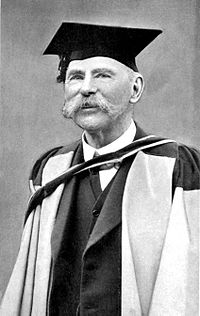Douglas Hyde
Douglas Ross Hyde MRIA (Irish: Dubhghlas de hÍde; 17 January 1860 – 12 July 1949), known as An Craoibhín Aoibhinn (lit. transl.Hyde helped establish the Gaelic Journal in 1892; in November, he wrote a manifesto called The necessity for de-anglicising the Irish nation,[8] arguing that Ireland should follow its own traditions in language, literature, and dress.[9] In 1893, he helped found Conradh na Gaeilge (the Gaelic League) to encourage the preservation of Irish culture, music, dance and language.A new generation of Irish republicans (including Pádraig Pearse, Éamon de Valera, Michael Collins and Ernest Blythe), became politicised through their involvement in Conradh na Gaeilge.He was elected to Seanad Éireann, the upper house of the Irish Free State's Oireachtas (parliament), at a by-election on 4 February 1925, replacing Sir Hutcheson Poë.Again his tenure proved short, even shorter than before; however, this time it was because Hyde was chosen, after inter-party negotiations—following an initial suggestion by Fine Gael—to be the first President of Ireland, to which office he was elected unopposed.The Irish Times reported it as follows: In the morning [Dr Hyde] attended a service in St. Patrick's Cathedral presided over by the Archbishop of Dublin, Dr. Gregg.Mr. de Valera and his Ministerial colleagues attended a solemn Votive Mass in the Pro-Cathedral, and there were services in the principal Presbyterian and Methodist churches, as well as in the synagogue.The attendance included all the members of the Dail and Senate with their ladies, members of the Judiciary and the chiefs of the Civil Service, Dr. Paschal Robinson, the Papal Nuncio at the head of the Diplomatic Corps, several Roman Catholic Bishops, the Primate of All Ireland, the Archbishop of Dublin, the Bishop of Killaloe, the heads of the Presbyterian and Methodist congregations, the Provost and Vice Provost of Trinity College, and the President of the National University.Hyde's selection and inauguration received worldwide media attention and was covered by newspapers in Australia, New Zealand, South Africa, Argentina, and even Egypt.His age and health obligated him to schedule periods of rest throughout his days, and his lack of political experience caused him to defer to his advisers on questions of policy and discretionary powers, especially to his Secretary, Michael McDunphy.[clarification needed] One of Hyde's last presidential acts was a visit to the German Ambassador Eduard Hempel, on 3 May 1945, to offer his formal condolences on the death of Adolf Hitler.Hyde was buried in Frenchpark, County Roscommon at Portahard Church, (where he had spent most of his childhood life) beside his wife Lucy, his daughter Nuala, his sister Annette, his mother Elizabeth, and his father Arthur.





Douglas Hyde (author)President of IrelandÉamon de ValeraSeán T. O'KellySenatorNominated by the Taoiseach17 September 1925CastlereaCounty RoscommonLittle RatraPhoenix ParkDublinFrenchparkIndependentLucy KurtzAlma materTrinity College DublinAcademicPoliticianLinguistGaelic revivalGaelic LeagueCastlehydeFermoyCounty CorkChurch of IrelandrectorCounty SligoCounty LeitrimCounty DublinprebendaryIrish languageAnglican clergymanHebrewCollege Historical Societylanguage revivalConradh na GaeilgeSociety for the Preservation of the Irish Languagepen nameGaelic JournalPádraig PearseMichael CollinsErnest BlytheEoin MacNeillSinn FéinSeanad ÉireannIrish Free StateOireachtasHutcheson Poë1925 Seanad electionCatholic Truth SocietyProtestantismUniversity College DublinAttorney General of IrelandChief Justice of IrelandCearbhall Ó DálaighSeries C Banknote1938 Irish presidential electionTaoiseachFine GaelW. T. Cosgravemade it unclearBritish monarchconfessional stateSeán MacEnteeDáil ÉireannDublin CastleThe Irish TimesSt. Patrick's CathedralArchbishop of DublinGeneral Post OfficeSean T. O'KellyPaschal RobinsonPrimate of All IrelandBishop of KillaloeÁras an UachtaráinJ. M. AndrewsPolandDalymount ParkConstitution of IrelandWorld War IICouncil of StateEduard Hempeldeath of Adolf HitlerSt. Patrick's Cathedral, Dublinstate funeralRoman Catholic Church in IrelandNoël BrowneLeader of the OppositionFianna FáilErskine H. ChildersRoscommonOranmoreCounty GalwayTallaghtGaelcholáisteSouth DublinDr. Hyde ParkRoscommon GAADouglas Hyde GalleryDictionary of Irish BiographyUniversity of California PressWayback MachineFaber & FaberIrish Statute BookIrish IndependentWikisourceProject GutenbergInternet ArchiveLibriVox20th Century Press ArchivesLord GlenavyTrinity College Historical SocietyPresidents of IrelandPatrick HilleryMary RobinsonMary McAleeseMichael D. HigginsEoin Mac NéillTomás Ó Néill RuiséalSeán Ó CellaighPeadar Toner Mac FhionnlaoichCormac BreathnachLiam Ó BuachallaSeán Ó TuamaDiarmuid Mac Fhionnlaoich